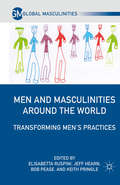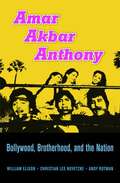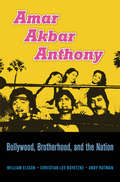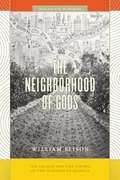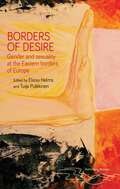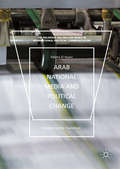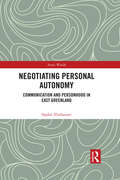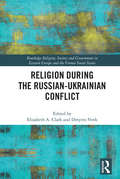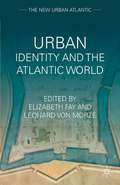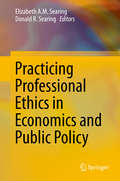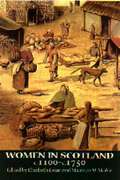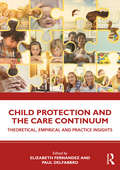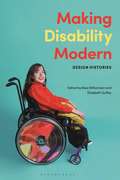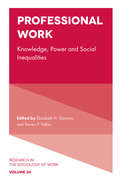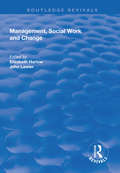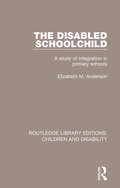- Table View
- List View
Men and Masculinities Around the World: Transforming Men’s Practices (Global Masculinities)
by Elisabetta Ruspini, Jeff Hearn, Bob Pease, and Keith PringleThis collection, with contributions on seventeen countries from social scientists from Africa, the Americas, Asia-Pacific, and Europe, analyzes the characteristics and potential of diverse educational, political and related initiatives towards progressive changes in gender relations to show how men are reacting to contemporary social change
Gender, Literatur und Film: Perspektiven auf die Literaturverfilmungen von Rainer Werner Fassbinder (Film)
by Aleksandra EliseevaWie interagieren Gender, Literatur und Film in literarischen Verfilmungen? Aleksandra Eliseeva widmet sich den Darstellungen von Gender in Rainer Werner Fassbinders Literaturadaptionen und fokussiert auf den komplexen Zusammenhang mehrerer Filme zu ihren Vorlagen. Auf den Spuren der Passionen des Regisseurs konfiguriert sie ein Makrowerk aus den Texten von Fontane, Döblin, Graf, Fleißer und Kroetz, das sie von den Filmen perspektiviert liest und welches sowohl inter- als auch intratextuelle Bezüge aufweist. Durch den polyperspektivischen, intermedialen Zugriff werden so die latenten Strukturen und persönlichen Lesarten der verfilmten Texte sichtbar.
Amar Akbar Anthony: Bollywood, Brotherhood, and the Nation
by William ElisonThe 1977 blockbuster Amar Akbar Anthony about the heroics of three Bombay brothers separated in childhood became a classic of Hindi cinema and a touchstone of Indian popular culture. Beyond its comedy and camp is a potent vision of social harmony, but one that invites critique, as the authors show.
Amar Akbar Anthony: Bollywood, Brotherhood, and the Nation
by William ElisonThe 1977 blockbuster Amar Akbar Anthony about the heroics of three Bombay brothers separated in childhood became a classic of Hindi cinema and a touchstone of Indian popular culture. Beyond its comedy and camp is a potent vision of social harmony, but one that invites critique, as the authors show.
The Neighborhood of Gods: The Sacred and the Visible at the Margins of Mumbai (South Asia Across the Disciplines)
by William ElisonThere are many holy cities in India, but Mumbai is not usually considered one of them. More popular images of the city capture the world’s collective imagination—as a Bollywood fantasia or a slumland dystopia. Yet for many, if not most, people who live in the city, the neighborhood streets are indeed shared with local gods and guardian spirits. In The Neighborhood of Gods, William Elison examines the link between territory and divinity in India’s most self-consciously modern city. In this densely settled environment, space is scarce, and anxiety about housing is pervasive. Consecrating space—first with impromptu displays and then, eventually, with full-blown temples and official recognition—is one way of staking a claim. But how can a marginalized community make its gods visible, and therefore powerful, in the eyes of others? The Neighborhood of Gods explores this question, bringing an ethnographic lens to a range of visual and spatial practices: from the shrine construction that encroaches on downtown streets, to the “tribal art” practices of an indigenous group facing displacement, to the work of image production at two Bollywood film studios. A pioneering ethnography, this book offers a creative intervention in debates on postcolonial citizenship, urban geography, and visuality in the religions of India.
The Neighborhood of Gods: The Sacred and the Visible at the Margins of Mumbai (South Asia Across the Disciplines)
by William ElisonThere are many holy cities in India, but Mumbai is not usually considered one of them. More popular images of the city capture the world’s collective imagination—as a Bollywood fantasia or a slumland dystopia. Yet for many, if not most, people who live in the city, the neighborhood streets are indeed shared with local gods and guardian spirits. In The Neighborhood of Gods, William Elison examines the link between territory and divinity in India’s most self-consciously modern city. In this densely settled environment, space is scarce, and anxiety about housing is pervasive. Consecrating space—first with impromptu displays and then, eventually, with full-blown temples and official recognition—is one way of staking a claim. But how can a marginalized community make its gods visible, and therefore powerful, in the eyes of others? The Neighborhood of Gods explores this question, bringing an ethnographic lens to a range of visual and spatial practices: from the shrine construction that encroaches on downtown streets, to the “tribal art” practices of an indigenous group facing displacement, to the work of image production at two Bollywood film studios. A pioneering ethnography, this book offers a creative intervention in debates on postcolonial citizenship, urban geography, and visuality in the religions of India.
The Neighborhood of Gods: The Sacred and the Visible at the Margins of Mumbai (South Asia Across the Disciplines)
by William ElisonThere are many holy cities in India, but Mumbai is not usually considered one of them. More popular images of the city capture the world’s collective imagination—as a Bollywood fantasia or a slumland dystopia. Yet for many, if not most, people who live in the city, the neighborhood streets are indeed shared with local gods and guardian spirits. In The Neighborhood of Gods, William Elison examines the link between territory and divinity in India’s most self-consciously modern city. In this densely settled environment, space is scarce, and anxiety about housing is pervasive. Consecrating space—first with impromptu displays and then, eventually, with full-blown temples and official recognition—is one way of staking a claim. But how can a marginalized community make its gods visible, and therefore powerful, in the eyes of others? The Neighborhood of Gods explores this question, bringing an ethnographic lens to a range of visual and spatial practices: from the shrine construction that encroaches on downtown streets, to the “tribal art” practices of an indigenous group facing displacement, to the work of image production at two Bollywood film studios. A pioneering ethnography, this book offers a creative intervention in debates on postcolonial citizenship, urban geography, and visuality in the religions of India.
The Neighborhood of Gods: The Sacred and the Visible at the Margins of Mumbai (South Asia Across the Disciplines)
by William ElisonThere are many holy cities in India, but Mumbai is not usually considered one of them. More popular images of the city capture the world’s collective imagination—as a Bollywood fantasia or a slumland dystopia. Yet for many, if not most, people who live in the city, the neighborhood streets are indeed shared with local gods and guardian spirits. In The Neighborhood of Gods, William Elison examines the link between territory and divinity in India’s most self-consciously modern city. In this densely settled environment, space is scarce, and anxiety about housing is pervasive. Consecrating space—first with impromptu displays and then, eventually, with full-blown temples and official recognition—is one way of staking a claim. But how can a marginalized community make its gods visible, and therefore powerful, in the eyes of others? The Neighborhood of Gods explores this question, bringing an ethnographic lens to a range of visual and spatial practices: from the shrine construction that encroaches on downtown streets, to the “tribal art” practices of an indigenous group facing displacement, to the work of image production at two Bollywood film studios. A pioneering ethnography, this book offers a creative intervention in debates on postcolonial citizenship, urban geography, and visuality in the religions of India.
The Neighborhood of Gods: The Sacred and the Visible at the Margins of Mumbai (South Asia Across the Disciplines)
by William ElisonThere are many holy cities in India, but Mumbai is not usually considered one of them. More popular images of the city capture the world’s collective imagination—as a Bollywood fantasia or a slumland dystopia. Yet for many, if not most, people who live in the city, the neighborhood streets are indeed shared with local gods and guardian spirits. In The Neighborhood of Gods, William Elison examines the link between territory and divinity in India’s most self-consciously modern city. In this densely settled environment, space is scarce, and anxiety about housing is pervasive. Consecrating space—first with impromptu displays and then, eventually, with full-blown temples and official recognition—is one way of staking a claim. But how can a marginalized community make its gods visible, and therefore powerful, in the eyes of others? The Neighborhood of Gods explores this question, bringing an ethnographic lens to a range of visual and spatial practices: from the shrine construction that encroaches on downtown streets, to the “tribal art” practices of an indigenous group facing displacement, to the work of image production at two Bollywood film studios. A pioneering ethnography, this book offers a creative intervention in debates on postcolonial citizenship, urban geography, and visuality in the religions of India.
The Neighborhood of Gods: The Sacred and the Visible at the Margins of Mumbai (South Asia Across the Disciplines)
by William ElisonThere are many holy cities in India, but Mumbai is not usually considered one of them. More popular images of the city capture the world’s collective imagination—as a Bollywood fantasia or a slumland dystopia. Yet for many, if not most, people who live in the city, the neighborhood streets are indeed shared with local gods and guardian spirits. In The Neighborhood of Gods, William Elison examines the link between territory and divinity in India’s most self-consciously modern city. In this densely settled environment, space is scarce, and anxiety about housing is pervasive. Consecrating space—first with impromptu displays and then, eventually, with full-blown temples and official recognition—is one way of staking a claim. But how can a marginalized community make its gods visible, and therefore powerful, in the eyes of others? The Neighborhood of Gods explores this question, bringing an ethnographic lens to a range of visual and spatial practices: from the shrine construction that encroaches on downtown streets, to the “tribal art” practices of an indigenous group facing displacement, to the work of image production at two Bollywood film studios. A pioneering ethnography, this book offers a creative intervention in debates on postcolonial citizenship, urban geography, and visuality in the religions of India.
Borders of desire: Gender and sexuality at the Eastern borders of Europe (Rethinking Borders)
by Elissa Helms and Tuija PulkkinenBorders of desire takes a novel approach to the study of borders: rather than seeing them only as obstacles to the fulfillment of human desires, this collection focuses on how borders can also be productive of desire. Based on long-term ethnographic engagement with sites along the eastern borders of Europe, particularly in the Baltics and the Balkans, the studies in this volume illuminate how gendered and sexualized desires are generated by the existence of borders and how they are imagined. As the chapters show, borders can create new desires expressed as aspirations, resentments, and actions including physical movements across borders for pleasure or work, or collective enactments of political ideals or resistance. The collection also shows how the persistent east/west symbolic border continues to act as a source of these desires in European political and social life.
Arab National Media and Political Change: “Recording the Transition” (The Palgrave Macmillan Series in International Political Communication)
by Fatima El-IssawiThis book examines the evolution of national Arab media and its interplay with political change, particularly in emerging democracies in the context of the Arab uprisings. Investigated from a journalistic perspective, this research addresses the role played by traditional national media in consolidating emerging democracies or in exacerbating their fragility within new political contexts. Also analyzed are the ways journalists report about politics and transformations of these media industries, drawing on the international experiences of media in transitional societies. This study builds on a field investigation led by the author and conducted within the project “Arab Revolutions: Media Revolutions,” covering Libya, Tunisia, and Egypt.
Arab National Media and Political Change: “Recording the Transition” (The Palgrave Macmillan Series in International Political Communication)
by Fatima El-IssawiThis book examines the evolution of national Arab media and its interplay with political change, particularly in emerging democracies in the context of the Arab uprisings. Investigated from a journalistic perspective, this research addresses the role played by traditional national media in consolidating emerging democracies or in exacerbating their fragility within new political contexts. Also analyzed are the ways journalists report about politics and transformations of these media industries, drawing on the international experiences of media in transitional societies. This study builds on a field investigation led by the author and conducted within the project “Arab Revolutions: Media Revolutions,” covering Libya, Tunisia, and Egypt.
Negotiating Personal Autonomy: Communication and Personhood in East Greenland (Arctic Worlds)
by Sophie ElixhauserNegotiating Personal Autonomy offers a detailed ethnographic examination of personal autonomy and social life in East Greenland.Examining verbal and non-verbal communication in interpersonal encounters, Elixhauser argues that social life in the region is characterized by relationships based upon a particular care to respect other people’s personal autonomy. Exploring this high valuation of personal autonomy, she asserts that a person in East Greenland is a highly permeable entity that is neither bounded by the body nor even necessarily human. In so doing, she also puts forward a new approach to the anthropological study of communication.An important addition to the corpus of ethnographic literature about the people of East Greenland, Elixhauser‘s work will be of interest to scholars of the Arctic and the North, Greenland, social and cultural anthropology, and human geography. Her conclusion that, in East Greenland, the ‘inner’ self cannot be separated from the ‘public’ persona will also be of interest to scholars working on the self across the humanities and social sciences.
Negotiating Personal Autonomy: Communication and Personhood in East Greenland (Arctic Worlds)
by Sophie ElixhauserNegotiating Personal Autonomy offers a detailed ethnographic examination of personal autonomy and social life in East Greenland.Examining verbal and non-verbal communication in interpersonal encounters, Elixhauser argues that social life in the region is characterized by relationships based upon a particular care to respect other people’s personal autonomy. Exploring this high valuation of personal autonomy, she asserts that a person in East Greenland is a highly permeable entity that is neither bounded by the body nor even necessarily human. In so doing, she also puts forward a new approach to the anthropological study of communication.An important addition to the corpus of ethnographic literature about the people of East Greenland, Elixhauser‘s work will be of interest to scholars of the Arctic and the North, Greenland, social and cultural anthropology, and human geography. Her conclusion that, in East Greenland, the ‘inner’ self cannot be separated from the ‘public’ persona will also be of interest to scholars working on the self across the humanities and social sciences.
Religion During the Russian Ukrainian Conflict (Routledge Religion, Society and Government in Eastern Europe and the Former Soviet States)
by Elizabeth A. Clark; Dmytro VovkThis book investigates how the military conflict between Russia and Ukraine has affected the religious situation in these countries. It considers threats to and violations of religious freedom, including those arising in annexed Crimea and in the eastern part of Ukraine, where fighting between Ukrainian government forces and separatist paramilitary groups backed and controlled by Russia is still going on, as well as in Russia and Ukraine more generally. It also assesses the impact of the conflict on church-state relations and national religion policy in each country and explores the role religion has played in the military conflict and the ideology surrounding it, focusing especially on the role of the Ukrainian and Russian Orthodox churches, as well as on the consequences for inter-church relations and dialogue.
Urban Identity and the Atlantic World (The New Urban Atlantic)
by Elizabeth A. Fay and Leonard von MorzéThe constant flow of people, ideas, and commodities across the Atlantic propelled the development of a public sphere. Chapters explore the multiple ways in which a growing urban consciousness influenced national and international cultural and political intersections.
Practicing Professional Ethics in Economics and Public Policy
by Elizabeth A.M. Searing Donald R. SearingThis volume explores the professional ethics of addresses the varied ethical needs of the professional economists and public policy professionals. Using terms and methods familiar to the reader, the book goes beyond the typical narrative of economics and morality to walk the professional through the process of ethical decision-making. Designed to be easy to navigate and applicable to everyday practice, this book includes a step-by-step illustrated guide through an ethical decision-making process using a methodology specifically tailored to economists and policy professionals. It describes numerous unique ethical tests and resolution methods which are utilized in a portfolio structure. The book also includes a brief and convenient catalogue of important figures in philosophy and ethics, translated into their policy applications; it concludes with candid advice from experts in different subfields on how ethics impacts their professional lives. This volume provides a foundation and framework for those in economics and public policy to implement a relevant practice of professional ethics both at and in their work.
Women in Scotland, c.1100-c.1750
by Elizabeth Ewan and Maureen M. MeikleThis collection of essays addresses women in Scotland in the medieval and early modem period, drawing on archival sources from Court of Session records to Middle Scots poetry. The editors argue persuasively that it is important to know about Scotswomen from all social levels. The book includes a time line and introductory bibliographical essay. The twenty essays in the collection are arranged under the themes of religion, literature, legal history, the economy, politics and the family. They demonstrate the connections between Scottish women's experience and those in England and the continent, as well as highlighting what was unique for the history of Scottish women.Through this comprehensive review of the feminine situation during more than six hundred years of Scottish history, the reader will discover how women really lived and what they really thought, whatever their place in society.
Child Protection and the Care Continuum: Theoretical, Empirical and Practice Insights
by Elizabeth Fernandez and Paul DelfabbroThis important new book critically examines the complex policy and practice issues surrounding child protection, including the impact of theoretical orientations, contemporary debates, policy initiatives and research findings, and maintains an emphasis on the ethics and values underpinning child welfare interventions. The book introduces policies that are central to understanding the position and needs of children and young people, and how policy and practice have been influenced by developments including the children’s rights agenda. It also explores the most significant issues in child welfare. These include: the experience of maltreatment by children, the systems of child protection to safeguard them, the methods and challenges of risk assessment, and the wide range of policy and therapeutic interventions to respond to children’s needs. The book also examines family support to promote children’s wellbeing before considering provision for children and young people who are looked after in out-of-home care. There is also a final section that focuses on best practice in communicating and working with children and young people, drawing on participatory, rights-oriented and resilience-based approaches, and supporting foster and adoptive carers and biological parents. Contributing in a substantive and clear manner to a growing international conversation about the present function and future directions for child welfare in contemporary societies, this textbook will be of interest to undergraduate and postgraduate social work students and those from allied disciplines, and professionals who are engaged in child welfare services.
Making Disability Modern: Design Histories
by Elizabeth Guffeyand Bess WilliamsonMaking Disability Modern: Design Histories brings together leading scholars from a range of disciplinary and national perspectives to examine how designed objects and spaces contributes to the meanings of ability and disability from the late 18th century to the present day, and in homes, offices, and schools to realms of national and international politics. The contributors reveal the social role of objects - particularly those designed for use by people with disabilities, such as walking sticks, wheelchairs, and prosthetic limbs - and consider the active role that makers, users and designers take to reshape the material environment into a usable world. But it also aims to make clear that definitions of disability-and ability-are often shaped by design.
Professional Work: Knowledge, Power and Social Inequalities (Research in the Sociology of Work #34)
by Elizabeth H. Gorman and Steven P. ValasThe professions have undergone massive changes in recent decades, as globalization, information technology, bureaucratization and market competition have begun to envelop even the most prestigious occupations in contemporary societies. Ironically, at a time when expert knowledge has grown increasingly important, the 'golden age' of the professions has receded into the past. Professional autonomy, authority, and ethics are all under siege, and even their claims to exclusive control of knowledge face challenges on multiple fronts. Volume 34 of Research in the Sociology of Work explores how the professions are faring in this changed world, shedding new light on a field that has long been at the center of social science thinking about the economy, the state, and social order. Chapters in this volume explore a series of questions that are vital to modern life, such as: How has increased control by employers and clients altered the experience of work for professionals? What are the new bases of professional status? How are underrepresented groups faring within the professions? How do professionals respond to precarity and unemployment?
Management, Social Work and Change (Routledge Revivals)
by Elizabeth Harlow and John LawlerThis title was first published in 2000: This text focuses on developments in social work and its management. In doing so, it is of necessity multi-disciplinary: research and literature from the fields of management, organization and social policy, as well as social work, are drawn upon. The major theme of the book is change, which, paradoxically, appears to be the major constant. Change is everywhere and living with change is part of the "modern condition". As the various transformations of social work are articulated, their influence becomes apparent. Each process will constitute a theme around which the content of this book is introduced. Although these processes are interdependent, each will be dealt with in turn.
The Disabled Schoolchild: A Study of Integration in Primary Schools (Routledge Library Editions: Children and Disability)
by Anderson Elizabeth M.First published in 1973, this book considers the differences between mainstream schools and special educational needs schools, for children with learning disabilities. It contains a wealth of research data, case history material and reference to existing literature, designed to answer many questions which parents, heads, and schoolteachers have asked. Questions considered include whether children with disabilities do as well in ordinary schools as children without, whether they are as happy and well adjusted, and how they fit into the social structure of the class. The book also looks at whether much teasing occurs and how practical difficulties can be overcome.
The Disabled Schoolchild: A Study of Integration in Primary Schools (Routledge Library Editions: Children and Disability #2)
by Anderson Elizabeth M.First published in 1973, this book considers the differences between mainstream schools and special educational needs schools, for children with learning disabilities. It contains a wealth of research data, case history material and reference to existing literature, designed to answer many questions which parents, heads, and schoolteachers have asked. Questions considered include whether children with disabilities do as well in ordinary schools as children without, whether they are as happy and well adjusted, and how they fit into the social structure of the class. The book also looks at whether much teasing occurs and how practical difficulties can be overcome.
